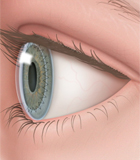Corneal Transplant Surgery in Illinois and Missouri

There are several different corneal transplant procedures available to help restore vision in patients with corneal problems. The traditional corneal transplant procedure involves replacing the entire damaged cornea with a healthy one from a human donor, which is usually obtained from an eye bank. However, technological advances have allowed for the development of specialized procedures that replace only the damaged part of the cornea, while leaving the healthy parts intact.
What Is DSAEK?
Short for Descemet's stripping and automated endothelial keratoplasty, DSAEK replaces only the innermost layers of cells within the cornea, known as the endothelium. This allows the procedure to be performed through a much smaller incision with shorter recovery times and fewer risks than a traditional corneal transplant.
Who Should Get DSAEK Surgery?
DSAEK is commonly performed on patients with Fuchs' Dystrophy, an inherited eye disease that causes the cells of the endothelium to deteriorate, resulting in distorted vision and corneal swelling. As this condition progresses, vision will continue to worsen as damaged cells cannot grow back.
The DSAEK Procedure

After the donor tissue has been placed, it will either unfold on its own or be unfolded by the surgeon. Another stitch will then be used to secure the new cornea in place, while an air bubble is injected to properly position it. This procedure is performed with a topical anesthetic to minimize any potential discomfort. The actual DSAEK procedure only takes about 20 to 30 minutes to perform, although patients should plan on being at the surgical facility for about two hours.
DSAEK Recovery
After the DSAEK procedure, patients will be moved to a recovery room, where they will be monitored for about an hour before being able to go home. Your doctor will prescribe antibiotic and steroid eye drops to be used for the next few days as the eye heals. You will need to return to your doctor the next day for a follow-up appointment as well.
Most patients notice improvements to their vision within the first two weeks after surgery, with results continuing to develop during the next four to six weeks. This is significantly faster than the traditional corneal transplant procedure, which may take six to 12 months before effective results are achieved. Other existing eye conditions may slow or hinder the improvement of vision after the DSAEK procedure.
What Are The Risks Of DSAEK Surgery?
While the DSAEK procedure is considered safe for most patients with cornea damage, there are certain risks involved with any type of surgical procedure, including infection, bleeding and more. Although rare, there is a risk of transplant rejection, which may result in redness, sensitivity to light and blurred vision. If you are experiencing these or any other symptoms after DSAEK, you should contact your doctor to prevent any damage from occurring.

